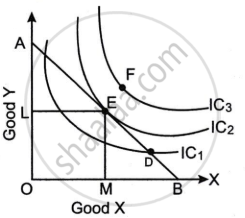Advertisements
Advertisements
प्रश्न
Refer to the diagram given below and answer the questions that follow.

- What does the line AB represent? Why is the line AB negatively sloped? (2)
- At which one of the given points, D, E and F, will the consumer attain equilibrium? Explain. (2)
- Briefly explain why the consumer is not in equilibrium at the other two points. (2)
उत्तर
- The "AB" line depends on the consumer's budget line. The budget line is negatively sloping because it reflects the trade-off between two items; because income is fixed, a customer must buy less of the other goods at fixed prices in order to afford more of one.
- The consumer will reach equilibrium at point E, where the budget line AB is tangent to the Indifference Curve IC2. To maximum satisfaction, the consumer purchases OM units of commodity X and OL units of commodity Y. There are two equilibrium conditions:
- Slope of IC = Slope of Budget Line
- Diminishing MRS
At point E, we are satisfied. All other points to the left or right of Budget Line are in disequilibrium.
- The customer is not in equilibrium at point F because, despite having a greater IC, it is outside the consumer's current income level.
The consumer is not in equilibrium at D because the marginal rate of substitution is less than the slope of the budget line, therefore the consumer is ready to give up very few units of Y to buy an extra unit of X commodity than the market requires. In other words, the customer values X commodity lower than its market worth. It drives consumers to buy less of X and more of Y, causing MRS to rise and the process continues again till MRS = slope of budget line.
APPEARS IN
संबंधित प्रश्न
A consumer consumes only two goods A and B and is in equilibrium. Show that when price of good B falls, demand for B rises. Answer this question with the help of utility analysis
A consumer consumes only two goods X and Y both priced at Rs 3 per unit. If the consumer chooses a combination of these two goods with Marginal Rate of Substitution equal to 3, is the consumer in equilibrium? Give reasons. What will a rational consumer do in this situation? Explain
A consumer consumes only two goods X and Y whose prices are Rs 4 and Rs 5 per unit respectively. If the consumer chooses a combination of the two goods with marginal utility of X equal to 5 and that of Y equal to 4, is the consumer in equilibrium? Give reason. What will a rational consumer do in this situation? Use utility analysis.
A consumer consumes only two goods, each priced at Rupee one per unit. If the consumer chooses a combination of the two goods with Marginal Rate of Substitution equal to 2, is the consumer in equilibrium? Give reasons. Explain what will a rational consumer do in this situation.
A consumer consumes only two goods X and Y whose prices are Rs 2 and Rs 1 per unit respectively. It the consumer chooses a combination of the two goods with marginal utility of X being 4 and that of Y also being 4, is the consumer in equilibrium ?Give reasons. Explain what will a rational consumer do in this situation. Use Marginal Utility Analysis.
If equilibrium price of a good is greater than its market price, explain all the changes that will take place in the market. Use diagram.
How does the equilibrium price of a ‘normal’ commodity change when income of its buyers falls? Explain the chain effects.
What are the conditions of consumer’s equilibrium under the indifference curve approach? What changes will take place if the conditions are not fulfilled to reach equilibrium?
From the following schedule find out the level of output at which the producer is in equilibrium, using marginal cost and marginal revenue approach. Give reasons for your answer.
|
Price per unit (Rs) |
Output (Units) |
Total Cost (Rs) |
|
8 |
1 |
6 |
|
7 |
2 |
11 |
|
6 |
3 |
15 |
|
5 |
4 |
18 |
|
4 |
5 |
23 |
Equilibrium price falls and equilibrium quantity rises when ______
Identify the correctly matched pair from Column A to that of Column B:
| Column A | Column B | ||
| (1) | Investment Multiplier | (a) | C + I + G + (X − M) |
| (2) | Marginal Propensity to Consume | (b) | `(ΔC)/(ΔY)` |
| (3) | Marginal Propensity to Save | (c) | `(ΔI)/(ΔY)` |
| (4) | Aggregate Demand | (d) | `(ΔS)/(ΔY)` |
What is the saturation point?
With the help of a diagram, explain how the consumer will attain equilibrium on the consumption of a single commodity at a given price.
